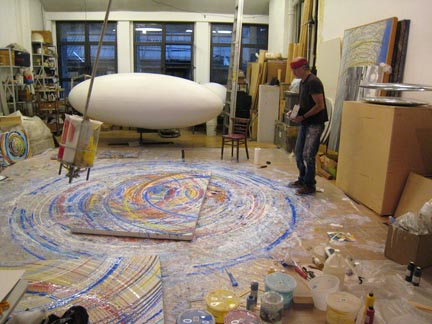The atmosphere is filled with ambient fields of energy: gravity, magnetism, radio waves, and a lot of other stuff, too.
To float my sculptures in the air, I secure permanent magnets inside them. The sculpture's concentrated fields interact with each other and with the atmosphere's
more dilute ambient fields to buoy the woods and metals in air like boats in water. The billowing shapes of these fields are complex, invisible and intangible. You can glide your hand through the air under the sculpture and not feel a thing.
.
My initial motivation in making a paint-dispensing pendulum was to create images of these fields with an instrument that is itself in the grip of the fields. My hope was that the field characteristics would automatically appear. They did. Imagery of bent space and the gravitational density gradient enveloping Earth reliably streams out of the pendulum as it generates its own orbit. Elliptical spiral patterns begin fast and spaced out, then gradually grow closer and slower as the pendulum winds its way back to hanging vertically, plumb with the center of the planet.
I love the subtlety of these elliptical shapes. Just as with the planetary orbits, the shapes are seldom true circles. Generally the paintings contain several overlapping orbits, on as many centers, laid down wet into wet. The orbital crossings render images of wave interference patterns. The connection to the cosmos via Earth's gravity is real.
Soon something surprising became evident: the interaction of multiple colors flowing simultaneously onto the canvas exhibited a strong capability to generate biomorphic imagery. These 'creatures of the deep' bring to mind familiar resemblances to plants and animals, but also to unfamiliar creatures as yet to be observed in nature (one reason why the show is called “New Nature”).
A bit about what the paintings are not. When first seeing these works, some otherwise interesting people exclaim "spin art", "spiralgraph", "Jackson Pollack." These techniques are, of course, somewhat related, but really have little in common with mine. By design, spin art has a single center, the paint flows out from the center
centrifically. As a result, not much variation is possible, and it has a strong association with carnivals and street fairs. Walter Robinson and Damien Hirst have used the technique and succeeded in making some fine paintings, but the compositions are highly limited by the technique. Spiralgraph is a plastic drawing aid with which many a person has made decorative rosettes, and other predictable patterns dictated by the device and limited to the linear by employing a pencil or a pen to make their marks. Very nice, but also very geometrical and limited in range of expression and quality. Jackson Pollack is of course closer in spirit and quality to my work. However, comparing my work side by side, it's readily apparent that the drip technique he employed had a lot to do with a specific type of pattern and type of overlapping linear marks, which conjures thoughts of neuron branching and tangled webs. It is unquestionably a well-known milestone in expanding possibilities in painting. Similarly, the inventive Surrealist painter Max Ernst did experiments with a little ink-filled can with a hole in the bottom, swung on a string to create some interesting patterns.
The paint pendulum instrument I designed for my work produces imagery of a very different sort than any of the above. I won't say much about it here, except that
it is a smooth interface with the ambient forces of nature and the results are very subtle, photographic-looking and unlimited in creating pictures of a new nature. I control the flow of colors with a radio-control-slide-switch mixing device, not unlike a musical instrument. The paint head is directed by hand. It can be used like a drawing instrument—a linear, orbiting pendulum. The possibilities are endless.
Tom Shannon
New York
March 2010
![[Francis Naumann]](/4logo.gif)
![[Francis Naumann]](/4logo.gif)


